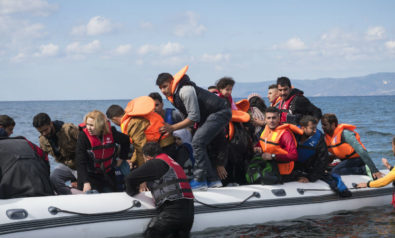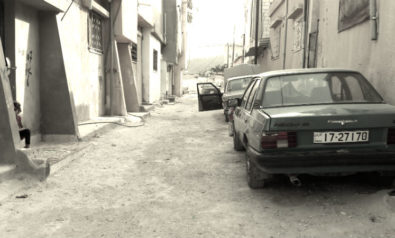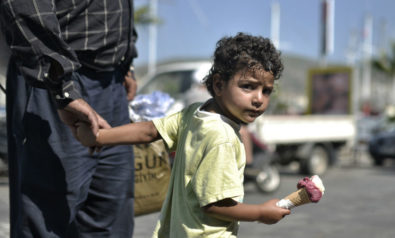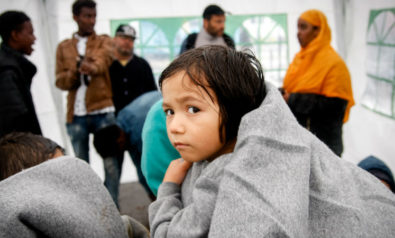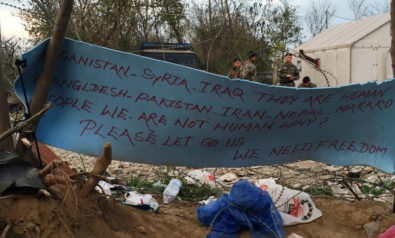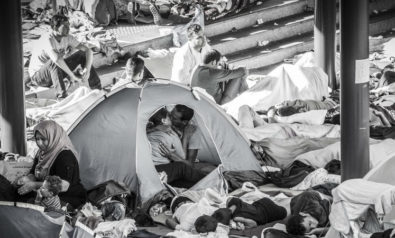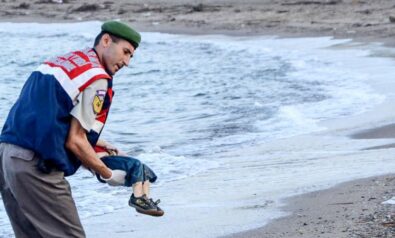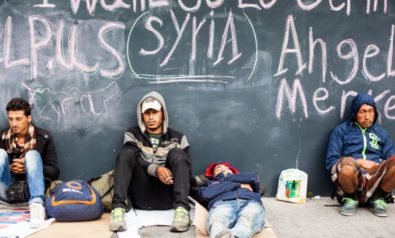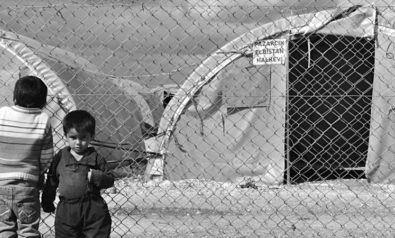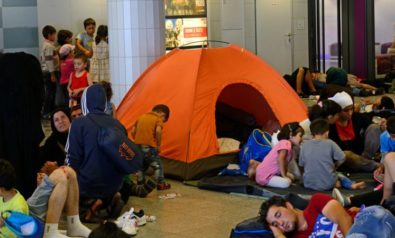The graphic nature of published images showing a dead Syrian child is a “game changer,” says Chaker Khazaal.
As viewed by most of the world, a Turkish police officer carries the lifeless body of a Syrian child, washed ashore on one of Turkey’s prime tourist resorts. The toddler, later identified as 3-year-old Aylan Kurdi, was found face down in the sand. Observers on the beach captured images of this heartbreaking moment, and the photographs and videos dominated social media and international news outlets.
Aylan was one of a dozen Syrian refugees who drowned in a failed attempt to cross the Mediterranean to reach the Greek island of Kos. The boy’s mother and 5-year-old brother were found further along the beach—both had drowned.
Circulation of these images multiplied at an alarming rate, sparking online controversy over the ethics of showcasing photographs of a deceased child.
Several news outlets eventually opted to publish the pictures. In Britain, newspapers across the political spectrum united in a decision to feature them on the front page of their publications. Many, such as The Independent, incorporated editor’s notes explaining their choice to publish the photos.
“The Independent has taken the decision to publish these images because, among the often glib words about the ‘ongoing migrant crisis,’ it is all too easy to forget the reality of the desperate situation facing many refugees,” the note read. “If these extraordinarily powerful images of a dead Syrian child washed up on a beach don’t change Europe’s attitude to refugees, what will?”
Fleeing the Middle East
The graphic nature of these published images is a “game changer,” giving the world a rare insight into the dire circumstances of the displacement crisis in the Middle East.
Millions of refugees have managed to escape either the violence gripping their homeland, or the harsh conditions of the majority of refugee camps in neighboring countries. Finding a new home is not easy, especially as some of the region’s more lucrative countries have refused to take in these displaced people. Many others make it difficult for refugees to relocate with full legal status, rendering them unable to secure aid and employment.
Some news outlets chose not to run the images. Vox Media cited concern that the pictures had become “less about compassion than about voyeurism.”
I completely understand the desire not to share, or even glance at the photos of this young child. There is no question these images are extremely distressing. But to those of us who have been following the displacement crisis, the fate of Aylan’s family—while certainly tragic—comes as no surprise.
The International Organization for Migration (IOM) reported that more than 2,700 people have died this year trying to navigate the Mediterranean into Europe, making it the most deadly migrant crossing point in the world. This is just one of the many dangerous routes taken by desperate refugees who often have no place to go except overcrowded camps in neighboring countries such as Jordan, Turkey or Lebanon.
In a study released this year by the United Nations High Commissioner for Refugees (UNHCR), it was reported that two-thirds of the Syrian refugees in Jordan were living below the international poverty line. With less than $40 a month per person to sustain themselves, refugee households often have to do without the very basic life necessities such as heating, electricity and basic plumbing.
Due to this appalling situation, many refugees rely on assistance from outside sources such as the United Nations World Food Programme. However, the organization said earlier this year that it was running out of money to feed refugees. It was reported in early July that the UN agency had already cut its food assistance for 1.6 million.
One image of the young refugee Aylan puts a face to a tragedy impossible to grasp with mere words. His family became one of several thousand who have lost their lives in search of a more humane existence. So while it’s natural not to feel “good” about sharing images of such a tragedy, we must understand the importance of documenting such catastrophic consequences.
Although thousands of migrants have already perished crossing the Mediterranean in 2015, the image of one drowned child has altered the way entire countries are viewing this catastrophe. Up to this point, the international community has struggled to find a permanent solution to the Middle East’s ongoing refugee crisis. Spanning over 65 years, this situation can be traced back to the displacement of millions of Palestinians as a result of the Arab-Israeli conflict of 1948.
Before Aylan’s family embarked on their final trip together, his aunt Tima Kurdi had been trying to secure their official Canadian refugee status.
“I was trying to sponsor them, and I have my friends and neighbors who helped me with the bank deposits,” Kurdi told the Ottawa Star. “But we couldn’t get them out, and that is why they went in the boat.”
As is the case with thousands of Syrian Kurdish refugees in Turkey, Aylan’s family was denied refugee status by the United Nations, as well as exit visas by the Turkish government. Without either of these, Citizenship and Immigration Canada was more than likely to reject the family’s request for Canadian refugee status—leaving them no choice but to get on that boat.
Chris Alexander, Canada’s minister of citizenship and immigration, announced he would be pausing his re-election campaign so he could travel to Ottawa and look further into why the family had been unable to achieve refugee status.
There is no doubt these images were going to encourage people to take a stand—an action from a reaction. It has become extremely difficult for the world’s leaders to ignore the plight of millions of refugees hoping for a better life.
Kim Murphy of The Los Angeles Times stressed how important it is for people to continue to share pictures that provoke emotion and raise awareness of the ongoing displacement crisis.
“The image is not offensive, it is not gory, it is not tasteless—it is merely heartbreaking, and stark testimony of the unfolding human tragedy that is playing out in Syria, Turkey, and Europe, often unwitnessed,” Murphy said. “We have written stories about hundreds of migrants found dead in capsized boats, sweltering trucks, and lonely rail lines, but it took a tiny boy on a beach to really bring it home to those readers who may not have yet grasped the magnitude of the migrant crisis.”
The Response
The powerful worldwide reaction generated by these images focuses on additional awareness to countries such as the United States and Britain, who haven’t quite pulled their weight to help alleviate displacement in the Middle East. The International Rescue Committee reports that the US has resettled only 1,541 of the over 4 million Syrian refugees since the civil war began five years ago. By contrast, Germany is expected to resettle an estimated 800,000 over the next year.
This map tweeted by Luay al-Khatteeb, nonresident fellow at the Brookings Institution, illustrates the disparity of refugee aid between Gulf Arab states and countries such as Jordan, Lebanon and Turkey.
Thanks to the voices that have been inspired by these graphic images, there will no doubt be more pressure than ever for these countries to open their borders to refugees in need.
Such was the case when British Prime Minister David Cameron had earlier this year referred to people fleeing Syria and Afghanistan as a “swarm.” The images of Aylan stirred such public outcry that the United Kingdom reacted to the crisis by announcing it would accept up to 20,000 refugees by 2020.
“The whole country has been deeply moved by the heartbreaking images we have seen over the past few days,” Cameron said. “It is absolutely right that Britain should fulfill its moral responsibility to help those refugees just as we have done so proudly throughout our history.”
Confrontational visuals remain a crucial element of engaging the population and prominent public figures in addressing a solution with meaningful outcomes.
If a picture is worth a thousand words, could it also save a thousand lives?
The views expressed in this article are the author’s own and do not necessarily reflect Fair Observer’s editorial policy.
Photo Credit: Getty Images
 We bring you perspectives from around the world. Help us to inform and educate. Your donation is tax-deductible. Join over 400 people to become a donor or you could choose to be a sponsor.
We bring you perspectives from around the world. Help us to inform and educate. Your donation is tax-deductible. Join over 400 people to become a donor or you could choose to be a sponsor.
Support Fair Observer
We rely on your support for our independence, diversity and quality.
For more than 10 years, Fair Observer has been free, fair and independent. No billionaire owns us, no advertisers control us. We are a reader-supported nonprofit. Unlike many other publications, we keep our content free for readers regardless of where they live or whether they can afford to pay. We have no paywalls and no ads.
In the post-truth era of fake news, echo chambers and filter bubbles, we publish a plurality of perspectives from around the world. Anyone can publish with us, but everyone goes through a rigorous editorial process. So, you get fact-checked, well-reasoned content instead of noise.
We publish 2,500+ voices from 90+ countries. We also conduct education and training programs
on subjects ranging from digital media and journalism to writing and critical thinking. This
doesn’t come cheap. Servers, editors, trainers and web developers cost
money.
Please consider supporting us on a regular basis as a recurring donor or a
sustaining member.
Will you support FO’s journalism?
We rely on your support for our independence, diversity and quality.




